|
Shining Like a Jewel
by Bob Brooke
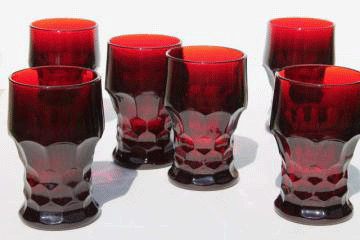 Ruby
glass is the dark red color of the precious gemstone ruby. This
popular Victorian color never went out of style and it’s still
cherished today as it was then. Ruby
glass is the dark red color of the precious gemstone ruby. This
popular Victorian color never went out of style and it’s still
cherished today as it was then.
Ruby glass has been around since Roman times. But the secret of
making red glass, lost for many centuries, wasn’t rediscovered until
the 17th Century in Brandenburg, Bohemia. Johann Kunckel, a chemist
from a glass-making family, re-discovered how to make gold ruby
glass around 1670.
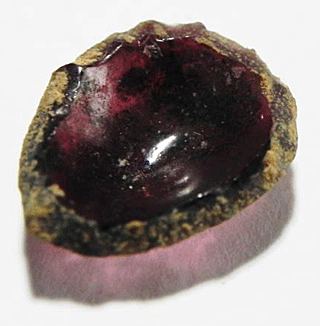 To
make gold ruby glass, include gold chloride, a colloidal gold
solution produced by dissolving gold metal in Aqua Regia (nitric
acid and hydrochloric acid) in the glass mixture. Tin (stannic
chloride) is sometimes added in tiny amounts, making the process
both difficult and expensive. The tin has to be present in the two
chloride forms because the stannous chloride acts as a reducing
agent to bring about the formation of the metallic gold. Depending
on the composition of the base glass, the ruby color can develop
during cooling, or the glass may have to be reheated to “strike’ the
color.” Today, glassmakers use selenium to make ruby glass. To
make gold ruby glass, include gold chloride, a colloidal gold
solution produced by dissolving gold metal in Aqua Regia (nitric
acid and hydrochloric acid) in the glass mixture. Tin (stannic
chloride) is sometimes added in tiny amounts, making the process
both difficult and expensive. The tin has to be present in the two
chloride forms because the stannous chloride acts as a reducing
agent to bring about the formation of the metallic gold. Depending
on the composition of the base glass, the ruby color can develop
during cooling, or the glass may have to be reheated to “strike’ the
color.” Today, glassmakers use selenium to make ruby glass.
Who Made Ruby Glass?
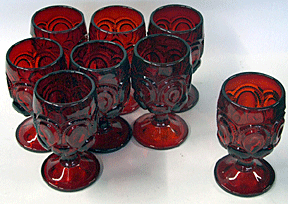 Over
the years, the number of companies making ruby glass has diminished.
Since the EPA has come down hard on these manufacturers, it has
become too costly to make ruby glass. Over
the years, the number of companies making ruby glass has diminished.
Since the EPA has come down hard on these manufacturers, it has
become too costly to make ruby glass.
Other than its inherent color and possible shape, ruby glass pieces
aren’t easily identified. Most Royal Ruby glass wasn’t marked or
signed. The glass usually came from the factory with a sticker
identifying the ruby color. During the 1940s, ruby glass
manufacturers began using stickers which eventually got washed off
or pulled off.
Major glass companies such as Sandwich, Cambridge, Mount Vernon,
Gadroon, Blenko, Paden City, Hostmaster, Glades, Fenton, and
Fostoria all made ruby glass in all the popular Depression glass
patterns—Old Cafe, Coronation, Sandwich, Oyster and Pearl, Queen
Mary, Manhattan.
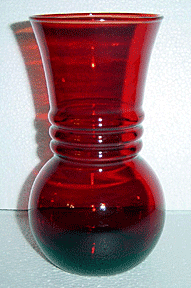 One
company, Anchor Hocking, became synonymous with the manufacture of
ruby glass. They initially began making and promoting it in 1938.
Anchor Hocking's glass, which the company called Royal Ruby, unlike
most handmade ruby, used a formula in which the principal colorant
was copper. The result, an evenly colored, dark red glass. The
amount of Royal Ruby in existence today is tremendous, far more than
the amount of red glass from other manufacturers. One
company, Anchor Hocking, became synonymous with the manufacture of
ruby glass. They initially began making and promoting it in 1938.
Anchor Hocking's glass, which the company called Royal Ruby, unlike
most handmade ruby, used a formula in which the principal colorant
was copper. The result, an evenly colored, dark red glass. The
amount of Royal Ruby in existence today is tremendous, far more than
the amount of red glass from other manufacturers.
Anchor Hocking’s first made Royal Ruby in 1939 in round plates in
dinner sets. Since this color became so popular, the company
produced pieces of other patterns in this ruby color, including
Oysters and Pearls, Old Cafe, Coronation, Bubble, Classic,
Manhattan, Queen Mary, and Sandwich. However, difficulty in
obtaining copper during World War II, halted production until 1949,
after which Anchor Hocking began making an assortment of novelty
items— apothecary jars, cigarette boxes, powder boxes, and
such—sometimes combining it with crystal.
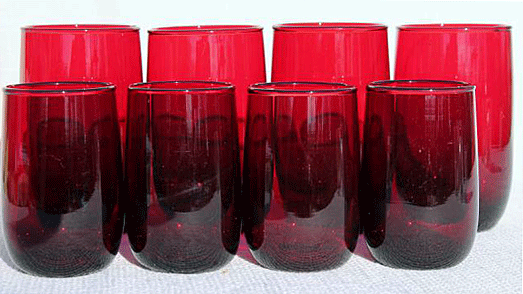
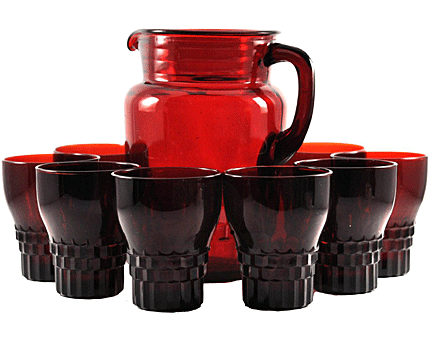 Footed
and unfooted sugar and creamer sets, jam jars with crystal bottoms and
ruby lids, plus assorted glasses--ribbed, old café, gold rimmed
tumblers, and footed wine goblets—were among the myriad of pieces made
in the late 1940s and early 1950s. Ice tea sets with large ice-lipped
pitchers and six to eight tumblers were especially popular. Footed
and unfooted sugar and creamer sets, jam jars with crystal bottoms and
ruby lids, plus assorted glasses--ribbed, old café, gold rimmed
tumblers, and footed wine goblets—were among the myriad of pieces made
in the late 1940s and early 1950s. Ice tea sets with large ice-lipped
pitchers and six to eight tumblers were especially popular.
Overall, ruby glass has appreciated in value because, like most glass
items, breakage causes scarcity. But many items still sell in the
affordable range of $15-65.
Cranberry Glass—A Ruby Glass Variant
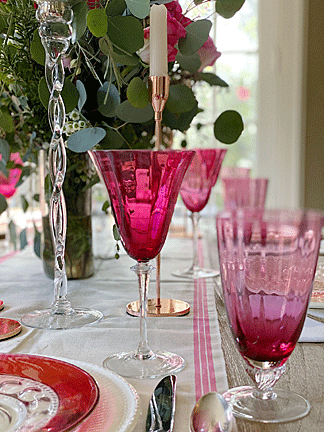 Hostesses
during the Victorian Era favored a lighter variant of ruby glass called
cranberry glass. And because of its scarcity, it’s usually pricier than
similar pieces of ruby glass. Hostesses
during the Victorian Era favored a lighter variant of ruby glass called
cranberry glass. And because of its scarcity, it’s usually pricier than
similar pieces of ruby glass.
To get a lighter pink color, English and American glassblowers
experimented with adding less gold chloride, resulting in what today
have become known as “cranberry” glass.
And thanks to the virtuosity of these glassblowers there seems to be an
endless variety of shapes and patterns of this glass on the market. In
addition to tumblers and water pitchers, there are salt cellars, sugar
shakers, cruets, jars, jugs, decanters, celery vases and finger bowls.
Among the widely used patterns are "Swirl," "Coin Dot," and "Daisy &
Fern." Some of the most rare and expensive items found from this time
period are beautiful lamps and other lighting fixtures.
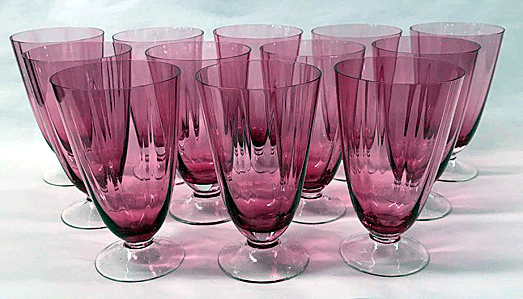
As with any collectible, cranberry glass can also be an investment.
Pieces that sold for less than $10 a generation ago are now worth
hundreds of dollars. Because of the natural fragility of glass, antique
cranberry glass has become relatively scarce, though it does turn up in
thrift and antique shops, flea markets, and auctions.
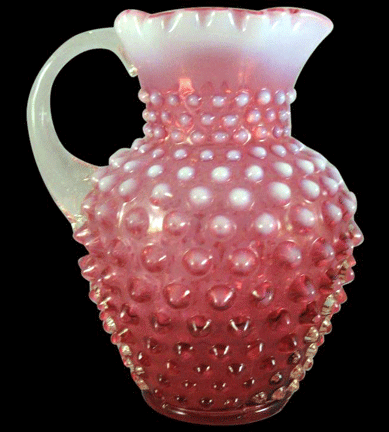 Although
cranberry glass had peaked in popularity by the end of the 19th century,
manufacturers produced it in quantity through the 1930s. The last two
companies to make this unique glass—The Pilgrim Glass Corporation and
Fenton Art Glass —went out of business early this century. Pilgrim Glass
Company produced beautiful blown cranberry glass ranging from various
vases and baskets to candle holders and sold them in department stores
and gift shops around the country until 2001. At the time if the
company's closing, cranberry was its most popular type of glass. Fenton
Art Glass marketed new cranberry glass, featuring opalescent decoration
with coin dots, daisy patterns and numerous other styles, through
retailers around the country until it closed in 2011. Although
cranberry glass had peaked in popularity by the end of the 19th century,
manufacturers produced it in quantity through the 1930s. The last two
companies to make this unique glass—The Pilgrim Glass Corporation and
Fenton Art Glass —went out of business early this century. Pilgrim Glass
Company produced beautiful blown cranberry glass ranging from various
vases and baskets to candle holders and sold them in department stores
and gift shops around the country until 2001. At the time if the
company's closing, cranberry was its most popular type of glass. Fenton
Art Glass marketed new cranberry glass, featuring opalescent decoration
with coin dots, daisy patterns and numerous other styles, through
retailers around the country until it closed in 2011.
Cranberry glass has always been made in smaller handcraft production
rather than in large quantities, due to the high cost of the gold and
the delicate mixing process required. Most cranberry pieces are hand
blown or molded and often contain small bubbles and striations.
<
Back to More Antique Spotlights
Next Article >
|
